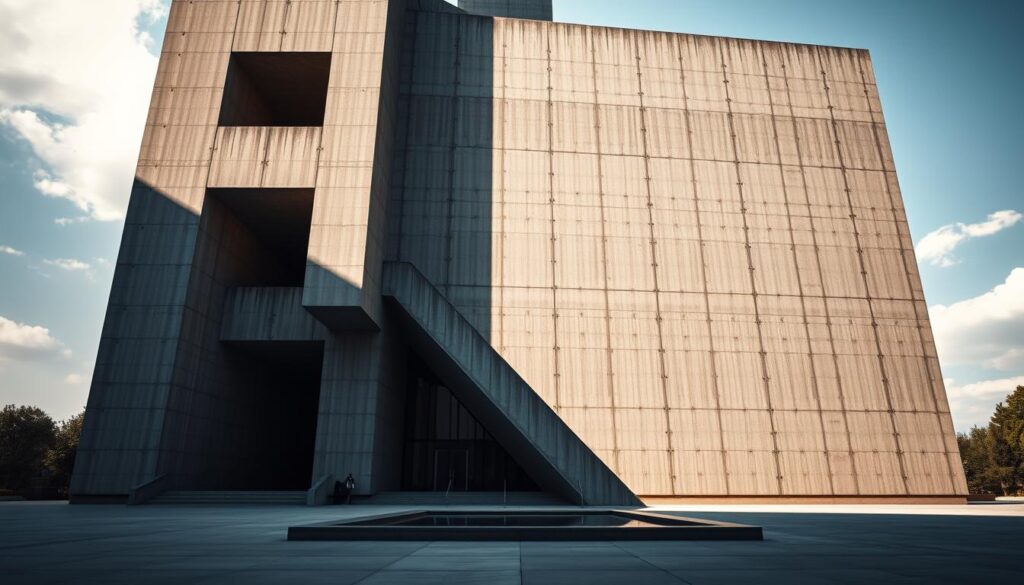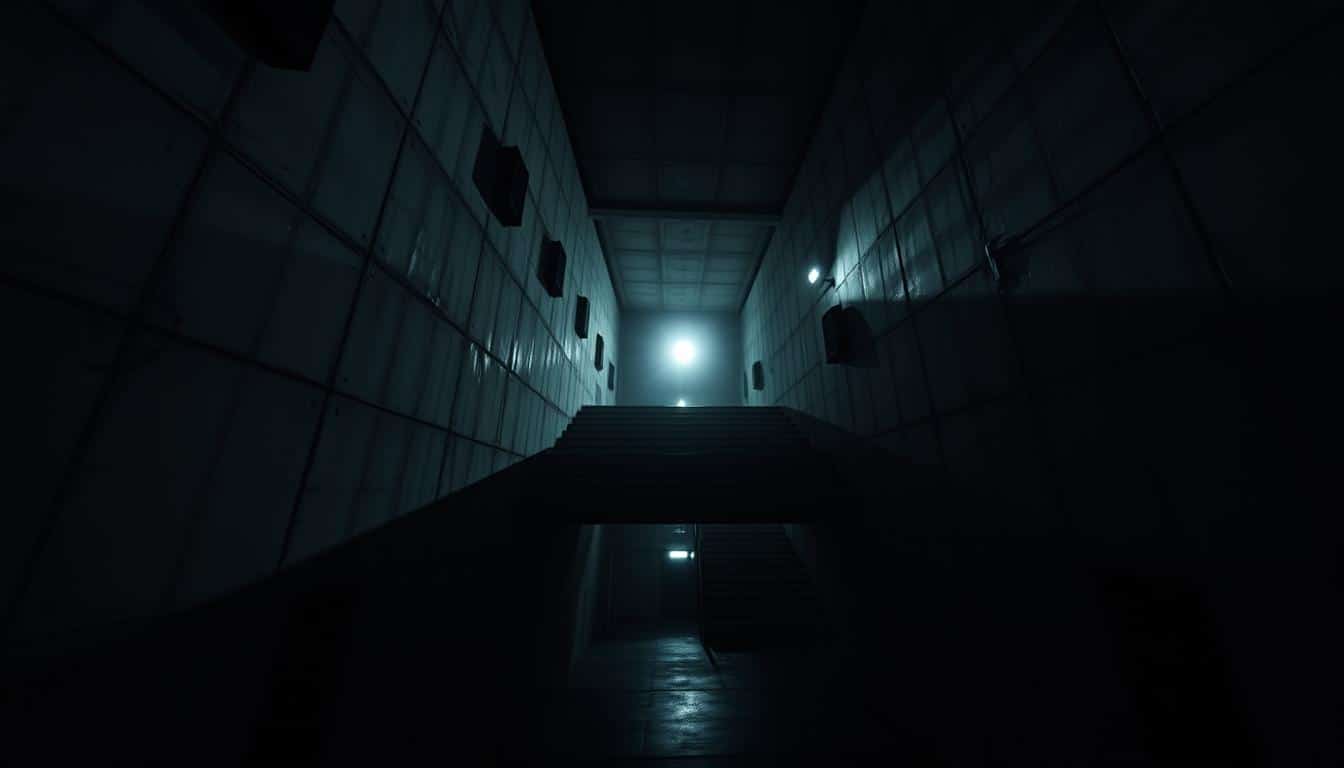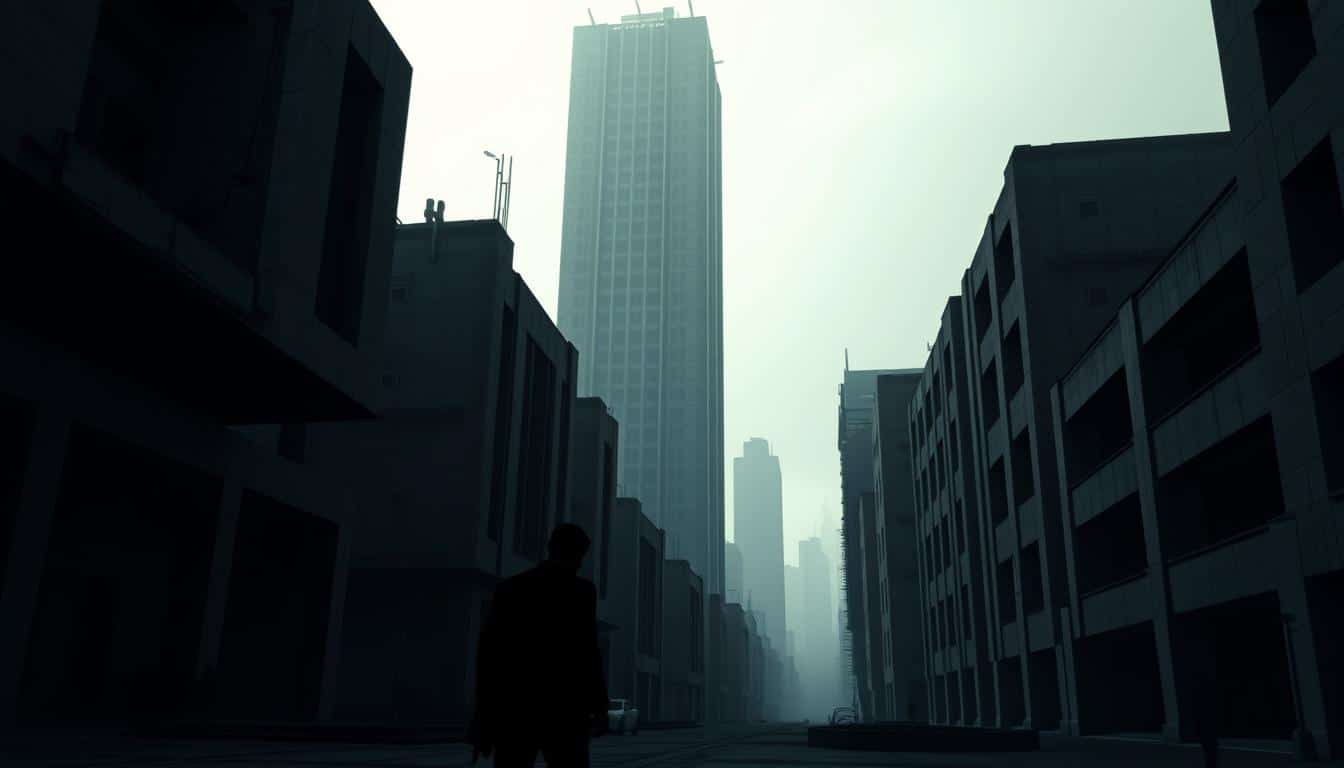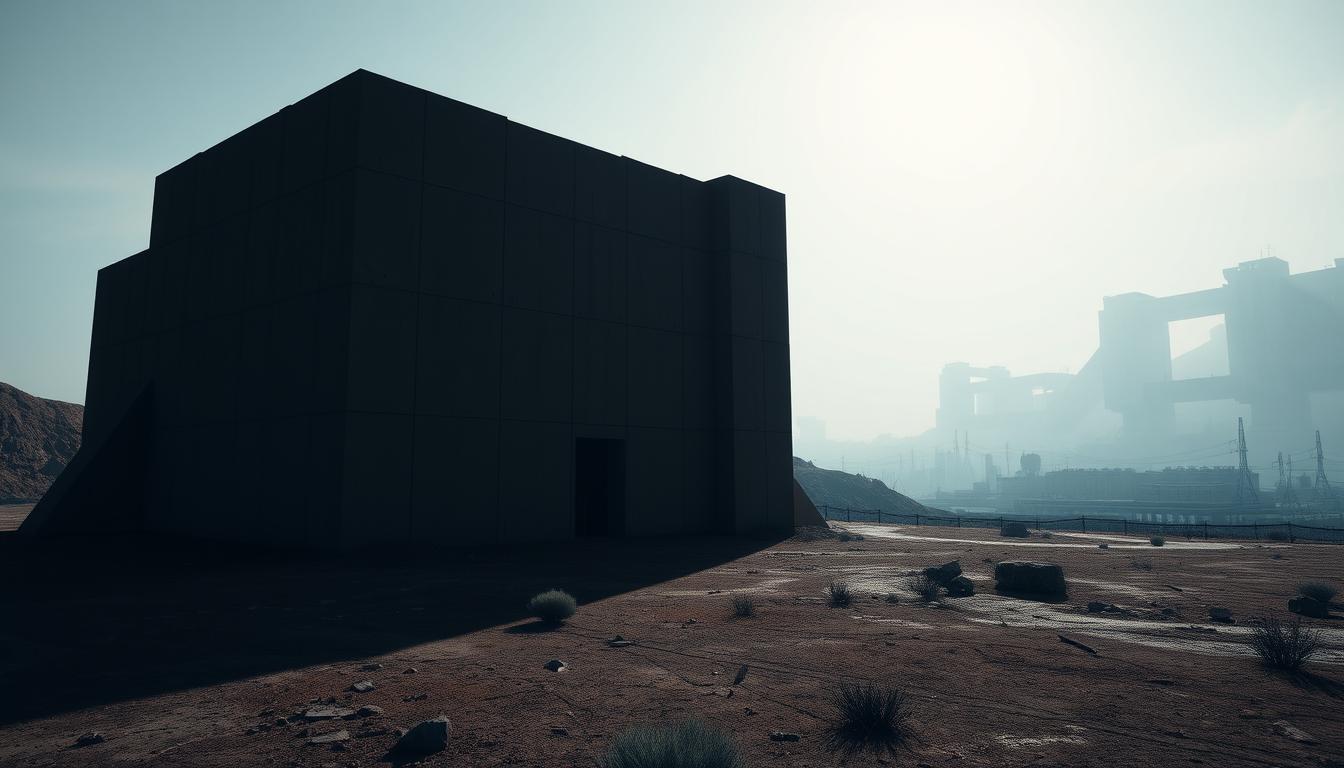Brutalism in video games is a strong storytelling tool. Its unique architectural styles stand out. These stark, raw environments shape many gaming experiences. They create an emotional setting for players to explore.
From concrete structures to minimalist designs, this architecture doesn’t just change visuals. It also affects the stories players live through. This article looks at how brutalist aesthetics make video game narratives richer. It shows us how immersion and emotional ties grow stronger in these concrete worlds.
Introduction to Brutalism in Architecture
Brutalist architecture is a key movement in the world of building styles. This brief look into brutalism highlights its main features. These include raw concrete builds, simple decorations, and designs focused on being useful. Brutalism started after the war, when there was a big need to rebuild and bring new ideas to cities.
After World War II, architects wanted to make spaces that were both useful and bold. They often chose rough materials and big shapes. These choices showed a move towards being open in how buildings were made. They also showed a wish for structures that showed strength and could last. People who like the bold look and deep ideas behind brutalism find these buildings interesting.
The thing about brutalism is that people either love it or they don’t. Some admire its strong way of expressing itself while others find it too bare. This ongoing debate still shapes talks about modern-day architecture. So, understanding brutalist architecture is key for those who love buildings and for experts in the field.

The Origins of Brutalist Architecture
Brutalist architecture began after World War II. This was a time marked by widespread destruction and the urgent need to rebuild. Architects drew inspiration from post-war architecture. They focused on designs that were functional and economical. Brutalism responded to the need for affordable, lasting buildings. This made it ideal for cities rebuilding from the war’s damages.
Post-War Rebuilding and Minimalism
In the late 1940s and 1950s, architecture started to embrace minimalism. Society wanted to leave traditional styles behind and move towards modernity. This led to a focus on raw materials, especially concrete. The era moved away from detailed decoration. This let the natural traits of materials shine through. The results were buildings that provided shelter and conveyed resilience and practicality. These qualities were key to post-war architecture.
Key Figures: Le Corbusier and Others
Le Corbusier was crucial to brutalism’s rise. His approach to architecture blended functionality with innovative design. This greatly influenced brutalism. With other leading architects, he popularized concrete as a main material. They explored new ways of architectural expression. Their work laid the groundwork for brutalism. It’s a style that still impacts architecture today.
Brutalism’s Aesthetic: Raw and Functional
Brutalism is known for its bold, straightforward style. It often uses bare concrete as its main material. This choice delivers a strong visual statement, showing off the beauty in simplicity and practicality. Buildings made this way have sharp lines and shapes, highlighting a no-frills approach that gets to the core of minimalist design.
Concrete as a Primary Material
Concrete is central to brutalism’s identity. It’s used for big structures that appear sturdy and timeless. The unrefined look of concrete not only defines buildings but also influences how we see space. When you enter a concrete space, you can feel its solidity, starting a conversation about durability and toughness. The often rough surface of exposed concrete breaks the traditional view of what makes architecture beautiful.
Minimalist Design Principles in Architecture
Minimalism is crucial to brutalism’s philosophy. Architects drop unnecessary decorations to spotlight the building’s purpose and shape. This mindset matches brutalism perfectly, as each part of a structure has a clear role. Designs with sharp lines and open spaces create a transparent environment. Here, people are encouraged to value the truth of the materials used. This minimalist style does not take away from the building’s beauty. Instead, it offers a new way to see beauty through concrete structures.
Symbolism of Brutalism in Video Game Narratives
Brutalist architecture makes video games more gripping. It adds depth with its bold designs and huge, harsh buildings. These elements in video games often symbolize control and power, which brutalist style shows well. Game makers use this style to make emotional spaces. This guides players as they tackle tough areas.
How Architecture Shapes Player Experience
In video games, how a place looks and the gameplay are closely linked. Brutalist buildings, with their plain concrete look, do more than just set the scene. They also affect how the game feels. Facing these daunting structures can make players feel uneasy. They underline the heavy hand of control in the game’s world. Players move through these spaces, hitting physical and emotional walls that show how trapped and alone they might feel.
Cultural References to Authority and Control
Brutalist styles show us a lot about society’s power structures. Their big scale and straight, hard lines push forward the idea of strength. This tension makes the game’s story even more gripping. As players walk these settings, the game’s deeper meanings on power, rule, and pushback come to light. This mix of building styles and power draws players deeper into the story. It gives layers of meaning that stick with them long after.
Examples of Brutalist Architecture in Video Games
Brutalist architecture impacts video games deeply, creating feelings of isolation. Games like NaissanceE and Control use this style for dramatic effect. They show how interactive environments can highlight the power of brutalism.
NaissanceE: A Journey Through Concrete Worlds
In NaissanceE, players explore a world filled with concrete giants. It’s a game that takes brutalism traits and weaves them into surreal adventures. The journey is lonely yet thought-provoking, with puzzles that emphasize the vast emptiness.
Control and the Oldest House’s Haunting Presence
Control brings players into the Oldest House, a mysterious brutalist building. This place is more than a backdrop; it shapes the story itself. Its endless corridors and the eerie atmosphere intensify the game’s themes, blending supernatural elements with a sense of being lost in a monumental structure.
Exploring Emotion through Brutalism
Brutalism in video games goes beyond just buildings. It taps into the emotions of players, creating a deep connection. The huge structures and plain environments make players feel alone. This choice stands out against more colorful game worlds. It lets players feel the loneliness that fills these places.
Creating a Sense of Isolation
Brutalism’s design and the feeling of being alone show up in cold, tough settings. Players find their way through concrete labyrinths and big, empty spaces. These places highlight how alone they are. This experience makes players think about their own sense of being apart from others. It deepens the emotional link to the game.
Brutalist architecture is key to the feel of dystopian games. It tells a story of emptiness and sadness. These games often talk about control and being crushed, making players face hard truths. The tense atmosphere and emotional design make the trip through these worlds unforgettable and deep.
Brutalism as a Metaphor for Power
Brutalism in video games often represents tough government power. Its large, firm buildings show how control dominates the game’s world. Players explore places that reveal deep stories about control and freedom.
Representation of Totalitarian Structures
Brutalist architecture in games stands for strict governments that don’t care about personal freedom. This style shows the cold and controlling side of power. The environments make players feel uneasy, making the game more engaging.
These settings help tell stories against controlling societies. They make players think about right and wrong under such rule.
Player Interaction with Environment and Themes
How players engage with brutalist settings is key. They interact with buildings and spaces to uncover the story. Facing challenges and making decisions show their influence in these harsh worlds.
This adds depth to the gaming adventure. Players think on power and freedom as they explore. Brutalism highlights these ideas, offering deep thoughts on modern challenges.
The Role of Liminal Spaces in Brutalism
In gaming, liminal spaces are key. They boost the story by using in-between areas. These spots foster exploration and uncertainty. They pull players into settings that test their views and feelings. Brutalist designs make this feeling stronger. They show the stark difference between what we know and the unknown.
How Transitional Spaces Enhance Narrative
Transitional spaces sit between defined spots. They let players move through areas that might seem unfinished. This design helps tell the story by:
- Creating a feeling of being lost or confused.
- Making players look closer at their environment.
- Offering chances for surprises or new discoveries.
These spaces carry a heavy emotional load. They mirror real human challenges. They show how we deal with uncertainty in games and life.
Brutalism as a Reflection of Human Conditions
Brutalism reflects the tough parts of human life. Its plain and raw style shows isolation, struggle, and staying strong. In games, this turns into:
- Places that make you feel open yet tough.
- Buildings that show our inner fights and social problems.
- The mix of beauty and harshness found in adventures.
So, liminal spaces in games are more than just transitions. They mirror complex human experiences. They blend the lines between real spaces and our emotions.
Brutalism’s Impact on Level Design
Brutalist architecture shapes level design in video games in unique ways. Developers use its stark, simple features to craft engaging game worlds. The mix of concrete and distinct shapes directs how players move and experience the story.
How Game Developers Utilize Brutalist Elements
Developers turn to brutalist elements to stir up emotions in players. This style adds a sense of size and heft to the game setting. Facing huge, daunting buildings, players can feel amazed yet trapped. Important elements include:
- Expansive yet oppressive spaces that challenge players’ perceptions
- Utilization of raw materials to enhance thematic depth
- Strategically placed corridors and open areas encouraging exploration
Building Immersion Through Architectural Choices
Architecture plays a key role in crafting immersive game environments. Brutalism’s unique look helps create an engaging atmosphere for the story. It focuses on space and interactive areas, making the game world more impactful. Good architectural decisions can:
- Encourage player movement and exploration
- Enhance emotional connection to the game narrative
- Shape player strategies and gameplay mechanics
The Social Context of Brutalist Structures
Brutalism tells us a lot about how people see cities and architecture. It started as a way to solve a housing crisis and show off progressive ideas. But soon, these buildings showed a mix of innovation and conflict in society.
When they first appeared, brutalist buildings aimed to fix city housing issues. They offered functional, cheap homes for urban folks seeking betterment. But people’s views changed over time. The cold, concrete structures made some feel trapped and alone. This shift made people argue over what is beautiful in cities full of modern, strong designs.
- Brutalism as a symbol of community identity
- The impact of urban development on societal well-being
- Transition from admiration to criticism
Changes in how we see these buildings touch on bigger worries. They’re not just about architecture trends but how buildings affect our lives together. These discussions keep going as we explore what these big structures mean for our cities and us as a community.
Critical Reception of Brutalism in Gaming
The way brutalism in gaming is received varies, showing how people react to different building styles. Aesthetics are crucial in making players feel a certain way, urging them to dive deep into the game’s world. Brutalist architecture brings out strong emotions, sparking discussions about its use and meaning.
Playing with Aesthetics and Emotional Responses
Brutalism in games triggers mixed feelings. Some love the bold, bare look, while others see it as gloomy. This divide shows how brutalism makes players examine their thoughts on harsh, concrete settings. Feelings towards these environments can range from admiration to unease, influenced by personal views and past gaming moments.
The Debate: Beauty vs. Oppression
Discussing brutalism often leads to talks on its beauty versus its daunting aspect. Critics say its severe, uncompromising shapes suggest a bleak future, aligning with game narratives. This controversy keeps the conversation alive about brutalism’s role in art and games. Players weigh its visual appeal against the discomfort it may cause.
Conclusion
This look into brutalism in video games shows its big impact on storytelling and feelings. The focus on brutalism points out that its bold, simple style doesn’t just create settings but also makes the gameplay better. Through different examples, we see brutalism helps tell stories about being alone, power, and rule.
After examining everything, we see how brutalism in games is changing. It’s already shaping how new games are made, pointing to its stick-around power. This opens up more talk about how building styles help craft deeply engaging game adventures.
As we think about brutalism’s future in games, there’s room for game makers to dive deeper into these design ideas. They can change how players see space and feel emotions. As game making gets better, blending building design with storytelling could change how we experience games.



